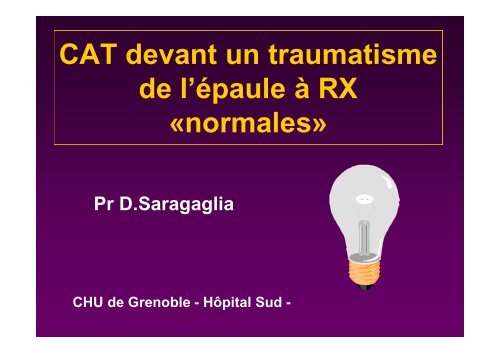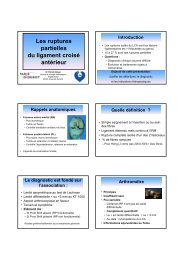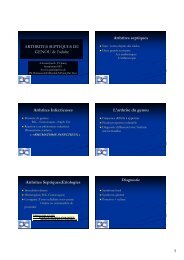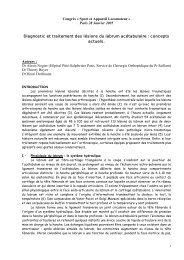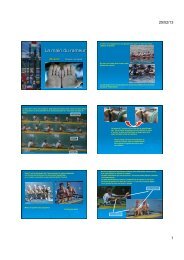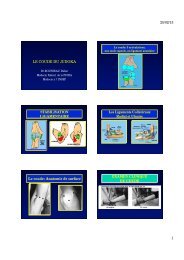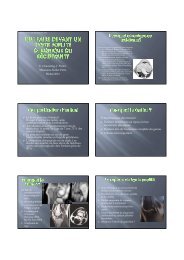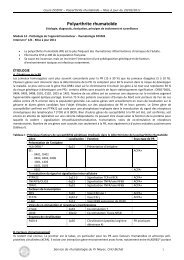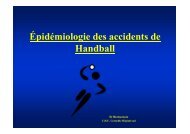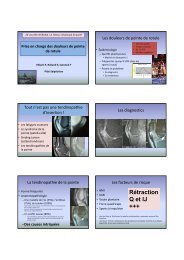CAT devant un traumatisme de l'épaule à RX normales - Pr Saragaglia
CAT devant un traumatisme de l'épaule à RX normales - Pr Saragaglia
CAT devant un traumatisme de l'épaule à RX normales - Pr Saragaglia
You also want an ePaper? Increase the reach of your titles
YUMPU automatically turns print PDFs into web optimized ePapers that Google loves.
<strong>CAT</strong> <strong><strong>de</strong>vant</strong> <strong>un</strong> <strong>traumatisme</strong><br />
<strong>de</strong> l’épaule à <strong>RX</strong><br />
«<strong>normales</strong>»<br />
<strong>Pr</strong> D.<strong>Saragaglia</strong><br />
CHU <strong>de</strong> Grenoble - Hôpital Sud -
Circonstances<br />
• Traumatisme <strong>de</strong> l’épaule<br />
-> Direct ou indirect<br />
• Douleur <strong>de</strong> l’épaule<br />
• impotence fonctionnelle +/- importante<br />
• <strong>RX</strong> «<strong>normales</strong>»
Clinique<br />
• Interrogatoire :<br />
- Mécanisme <strong>de</strong> l’acci<strong>de</strong>nt<br />
- Perception d’<strong>un</strong> craquement ou<br />
d’<strong>un</strong> déboitement<br />
- Impotence fonctionnelle immédiate<br />
ou secondaire
Examen<br />
• Torse nu, comparatif<br />
• Inspection -> à priori pas <strong>de</strong><br />
déformation<br />
• Palpation :<br />
- Clavicule<br />
- Art. acromio-claviculaire<br />
- Coracoï<strong>de</strong><br />
- Acromion<br />
- Tête humérale
• Mobilisation <strong>de</strong> l’épaule :<br />
- En actif<br />
. Élévation ant., rotation ext. (RE1<br />
et RE2), rotation int.<br />
- En passif<br />
• Force musculaire
Imagerie<br />
• Regar<strong>de</strong>r à nouveau les <strong>RX</strong> initiales :<br />
- Sont-elles vraiment «<strong>normales</strong>» ?<br />
- Si <strong>de</strong> mauvaise qualité<br />
-> Re<strong>de</strong>man<strong>de</strong>r <strong>de</strong>s <strong>RX</strong><br />
. Face, 3 rotations<br />
. Inci<strong>de</strong>nce <strong>de</strong> Garth<br />
. <strong>Pr</strong>ofil <strong>de</strong> Lamy<br />
. <strong>Pr</strong>ofil <strong>de</strong> Bernageau (si possible)<br />
. Pfs comparatifs
Diagnostics étiologiques<br />
1- Disjonction acromio-claviculaire<br />
- Sta<strong>de</strong> 1 ou 2 (car pas <strong>de</strong> déformation)<br />
- Douleur sur l’acromio-claviculaire<br />
- Clichés en stress (différencier 1 et 2)
2- Fracture non déplacée du trochiter<br />
- Douleur à la palpation du<br />
trochiter<br />
- Mobilité normale mais<br />
douloureuse<br />
- <strong>RX</strong> répétées (J+8 )
3- Instabilité antérieure <strong>de</strong> l’épaule<br />
- Subluxation ou E.D.E.I.M<br />
- Notion <strong>de</strong> déboitement<br />
- Pfs auc<strong>un</strong>e notion<br />
- Douleur en abd.-rot.-Ext.<br />
- Lésions <strong>de</strong> passage (+++) sur<br />
les <strong>RX</strong> (qualité +++)<br />
- TTT <strong>de</strong> l’instabilité antérieure
4- Rupture <strong>de</strong> la coiffe <strong>de</strong>s rotateurs<br />
- Épaule pseudo-paralytique<br />
-> dgc facile -> arthro-scanner<br />
- Autres cas :<br />
. Douleur à l’élévation ant.-Lat.<br />
. Jobe +<br />
. Diminution <strong>de</strong> la force musculaire<br />
. <strong>RX</strong> : . Pincement sous-acromial<br />
. Signes indirects <strong>de</strong> conflit<br />
. Revoir au bout <strong>de</strong> 8 à 10 jours<br />
-> si amélioration : kiné<br />
-> si i<strong>de</strong>m : arthro-scanner
5- Luxation postérieure <strong>de</strong> l’épaule<br />
- Rotation externe impossible<br />
- <strong>RX</strong> +++<br />
. Refaire <strong>RX</strong> si mauvaise<br />
qualité<br />
. Aspect <strong>de</strong> double contour<br />
. <strong>Pr</strong>ofil <strong>de</strong> Bloom et Obata<br />
- Scanner au moindre doute<br />
- Confier au chirurgien
6- La fracture du trochin<br />
. Passe volontiers inaperçue<br />
. Rotation interne douloureuse<br />
. Force en rotation interne diminuée<br />
. <strong>RX</strong> +++ -> profil <strong>de</strong> Lamy<br />
. Scanner au moindre doute
7- La contusion <strong>de</strong> l’épaule<br />
- Dgc d’élimination<br />
- Auc<strong>un</strong> <strong>de</strong>s diagnostics<br />
précé<strong>de</strong>nts<br />
- <strong>CAT</strong> :<br />
. Écharpe<br />
. Antalgiques +/- AINS<br />
. À revoir au bout <strong>de</strong> 8 à 10 jours
Conclusions<br />
• Se méfier <strong>de</strong>s <strong>RX</strong> «<strong>normales</strong>» :<br />
- sont-elles <strong>de</strong> bonne qualité?<br />
- Sont-elles vraiment <strong>normales</strong>?<br />
• Rééxaminer systématiquement <strong>un</strong>e<br />
épaule traumatisée au bout <strong>de</strong> 8 à 10<br />
jours
• Se méfier <strong>de</strong>s ruptures <strong>de</strong> coiffe chez<br />
l’adulte d’âge mur :<br />
-> svt aggravation d’<strong>un</strong>e rupture<br />
prééxistante<br />
• Se méfier <strong>de</strong> l’instabilité chez le<br />
je<strong>un</strong>e plus que <strong>de</strong> la rupture <strong>de</strong> coiffe<br />
• Les ruptures <strong>de</strong> coiffe traumatiques<br />
sont très rares chez le je<strong>un</strong>e (- <strong>de</strong> 30<br />
ans -> mais elles existent -> savoir y<br />
penser
Rupture <strong>de</strong> coiffe chez <strong>un</strong><br />
je<strong>un</strong>e <strong>de</strong> 22 ans


